
With its strict requirements and long development cycles, medical facilities can lag behind other areas when it comes to implementing AV solutions. Jones AV’s Ingo Aicher considers whether initiatives such as NHSX could help to change this.
With 8K technologies and panels experiencing their first push into the consumer market, 4K is just celebrating its successful entry into the operating theatres of the NHS.
The last ten years, which is a decade for most, but seems more like a century for the good people working AV technology, have seen the general cycles for introduction of new technology into the market getting shorter and quicker, however medical AV appears to be a different beast.
For obvious reasons, products used in operating theatres need to be specially designed, built and certified; splash proof, optimised for infection control, equipped with special medical power supplies, currency leak proof, the colour reproduction on monitors has to be accurate etc, etc. After all, in case you would ever need to be using the services of these kind of facilities, you too would want to know that the products used in such critical environments like operating theatres are safe and give the surgeon the best possible view to operate or diagnose. Given the staggering increase of minimal invasive surgeries, the likelihood of you coming into contact with this type of AV are ever increasing.
However, the downside of the regulations and the safety precautions are availability of new technology. Long development cycles result in high costs for these low volume high-end products. This combined with a chronically skint NHS in the UK and healthcare budgets experiencing constant cuts across Europe, means adoption rates of new technology in the OR are far beyond what they should be.
There is, of course, always the exception to the norm and like in so many other fields of technology, it is Europe’s early adopter nation Norway.
Back in 2008 entire hospitals where equipped with the latest flat panel medical monitors, broadcast-standard video routing systems networking entire OR departments and hospital campuses, fibre links, VCs for telemedicine, edit suites and high-end capture stations for attaching images and video to patient files.
While Norwegians enjoyed the advantages of this new generation of medical HD equipment and the first generation of medical LCD flat panels, the picture back home in the UK was in stark contrast; CRT monitors on composite and S-Video. Today S-Video sounds somewhat archaic, but in hospitals in the UK it is still very much present just like beepers, fax machines and indeed CRT monitors. Limited budgets mean that expensive medical equipment has to have a longer life cycle and therefore renewal programmes will take longer or can skip a generation of technology altogether. This is especially true with integrated operating theatres, where the AV is delivered by market-leading medical device manufacturers such as Storz and Olympus, which commands a premium price.
Back in Norway in early 2016, the first 4K integrated operating theatres in Europe got deployed, based on the new Barco Nexxis, uncompressed video over IP technology and Arthrex’s UHD4, the first 4K endoscope on the market.
While for the medical world this was quick, you will of course know that by then sales of 4K consumer TVs were about to outperform HD sets.
It wasn’t until 2018 that one of these 4K operating theatre systems found its way to the UK. Of course this wasn’t at an NHS facility but at Spire Healthcare’s private flagship hospital in Manchester.
As in other markets, technology prices tend to drop a few years after market introduction. The medical world is no different and the endoscope and other imaging device manufacturers have started to push more 4K devices into the market at a more affordable price. We can now see the first large NHS sites such as the new Royal Papworth in Cambridge boasting a 4K integrated system, which allows image routing, conferencing, image capture and electronic archiving of images and video with the patient files.
New initiatives like NHSX and the need for better patient data management through GDPR will indeed increase the uptake of new technologies in hospitals in the UK and operating theatres in particular. However, building new hospitals takes a very long time, refurbishments are complex and all things mentioned before such as protracted tender processes, long product life and development cycles, regulations on how to deal with sensitive patient data, which includes AV, means that the AV in operating theatres will always lag behind what you will have in consumer or broadcast markets.







